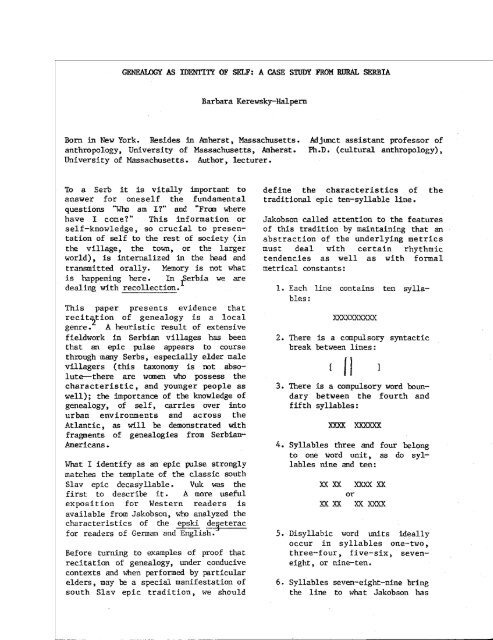Yugoslavia
Yugoslavia
Yugoslavia
Create successful ePaper yourself
Turn your PDF publications into a flip-book with our unique Google optimized e-Paper software.
GENEALOGY AS IDENTITY OF SELF: A CASE STUDY FROM RIJRAL SERBIA<br />
Barbara Kerewsky-Halpern<br />
Born in New York. Resides in Amherst, Massachusetts.<br />
anthropology, University of Massachusetts, Amherst.<br />
University of Massachusetts. Author, lecturer.<br />
To a Serb it is vitally important to<br />
answer for oneself the fundamental<br />
questions ,,1-0 am I?" and "Fran where<br />
have I cone?" This information or<br />
self-knowledge, so crucial to presentation<br />
of self to the rest of society (in<br />
the village, the town, or the larger<br />
world), is internalized in the head and<br />
transmitted orally. Memory is not what<br />
is happening here. In lSerbia we are<br />
dealing with recollection.<br />
This paper presents evidence that<br />
recit'2tion of genealogy is a local<br />
genre. A heuristic result of extensive<br />
fieldwork in Serbian villages has been<br />
that an epic pulse appears to course<br />
through many Serbs, especially elder male<br />
villagers (this taxonomy is not absolute-there<br />
are wanen who possess the<br />
characteristic, and younger people as<br />
well); the importance of the knowledge of<br />
genealogy, of self, carries over into<br />
urban environments and across the<br />
Atlantic, as will be demonstrated with<br />
fragments of genealogies from Serbian<br />
Americans.<br />
What I identify as an epic pulse strongly<br />
matches the template of the classic south<br />
Slav epic decasylIable. Vuk was the<br />
first to describe it. A more useful<br />
exposition for Western readers is<br />
available from Jakobson, who analyzed the<br />
characteristics of the epski de!jeterac<br />
for readers of German and English.<br />
Before turning to examples of proof that<br />
recitation of genealogy, under conducive<br />
contexts and when performed by particular<br />
elders, may be a special manifestation of<br />
south Slav epic tradition, we should<br />
Adjunct assistant professor of<br />
Ph.D. (cultural anthropology),<br />
define the characteristics of the<br />
traditional epic ten-syllable line.<br />
Jakobson called attention to the features<br />
of this tradition by maintaining that an<br />
abstraction of the underlying metrics<br />
must deal with certain rhythmic<br />
tendencies as well as with formal<br />
metrical constants:<br />
1. Each line contains ten syllables:<br />
xxxxxxxxxx<br />
2. There is a compulsory syntactic<br />
break between lines:<br />
[ II<br />
3. There is a compulsory word boundary<br />
between the fourth and<br />
fifth syllables:<br />
xxxx XXXXXX<br />
4. Syllables three and four belong<br />
to one word unit, as do syllables<br />
nine and ten:<br />
xx XX XXXX XX<br />
or<br />
XX XX XX XXXX<br />
5. Disyllabic word units ideally<br />
occur in syllables one-two,<br />
three-four, five-six) seveneight,<br />
or nine-ten.<br />
6. Syllables seven-eight-nine bring<br />
the line to whe t Jakobson has


